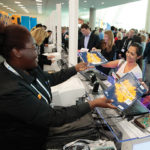What if a piece of technology could help visually impaired people find their way around a hotel room, or direct them to their coffee cup at the breakfast table, or help them make sure the light switch was turned off?
A Melbourne-based technology startup is offering exactly this type of assistance. The Aipoly platform uses artificial intelligence that operates through a smartphone camera to identify objects and speak them out loud. “If I’m blind, I can turn on this application and wave my phone around,” said Aipoly co-founder Alberto Rizzoli. “As it sees things, it will say out loud the object they’re pointing the phone at. We have people who cry the first time they use it.”
Recognizing the life-changing potential of their platform, Rizzoli and his two co-founders wanted to get the word out immediately after founding Aipoly last August, but they didn’t have vast resources. Then Aipoly entered and won the Consumer Technology Association (CTA) Foundation’s first-ever “Technology That Improves Lives” video contest. The prize: a free booth at CTA’s massive CES 2016, held in Las Vegas on Jan. 6–9.
The result was a textbook example of what the right trade show can do for the right idea.
SHOW AND TELL
Aipoly’s booth was located in Eureka Park, the “neighborhood” on CES’s show floor that’s dedicated to startups. Rizzoli and his team thought long and hard about how to distinguish themselves among the show’s 3,900 exhibiting companies to its more than 170,000 attendees from 150 countries. For starters, they decorated their 10-foot-by-10-foot booth with banners featuring Aipoly’s teal-colored logo. But there was still the question of how to draw in attendees when neighboring booths featured robots, flying machines, and other dazzling hardware. “Because presenting a smartphone application is not a very visual element,” Rizzoli said, “we had to figure something out.”
Aipoly opted to go in the other direction, with a straightforward display that featured everyday objects — a dollar bill, a teddy bear, a pair of scissors, a bottle of water, a receipt — and let visitors experiment with the technology. There was also a banner with the words “artificial intelligence,” which Rizzoli said helped attract attendees thanks to AI’s current buzz levels.
The live demonstration of the app was popular enough that it created a bottleneck in front of the booth, which helped stop traffic and encouraged even more attendees to check out what was happening. “The most successful booths have that line,” Rizzoli said, “which creates a fear of missing out.”
One challenge was the location of CES’s Startup Stage right in front of the Aipoly booth. When presentations were taking place, some attendees were uncomfortable walking “behind” the stage, where Aipoly was situated. That slowed traffic during presentation times.
In addition, Rizzoli thinks he and his team could have better managed the time they spent at the booth. At one point, only one person was manning the booth — because everyone else wanted to explore CES — and a huge influx of attendees came in. “In hindsight,” Rizzoli said, “we should have had a schedule in which two people manned the booth during periods of high demand.”
Another beginner’s lesson: business cards. Aipoly brought just enough to CES — burning through two boxes containing 1,000 cards each. Next time, they’ll bring more.
VISUALIZING THE FUTURE
Rizzoli considers both the booth and Aipoly’s overall experience at CES a success, with several business opportunities having arisen from the exposure. The company was even profiled in a nine-minute video as part of the Las Vegas Convention & Visitors Authority’s Unconventional series. And the cameras often attracted even more visitors to the booth.
The company’s next step is to start thinking beyond the visually impaired community, to other applications its AI platform might have. Aipoly is looking to integrate its software into toys, for example, so a child could wave an object in front of a camera and learn vocabulary, and into a video translator for security cameras, so security personnel might better understand what they’re seeing on a screen.
The company is “honored” by the support and interest from groups and people working on issues for the visually impaired, Rizzoli said, but “we know we still have a lot of work to do on the product. This technology is very cutting-edge and very scientific. There’s a lot we can do to improve.”




